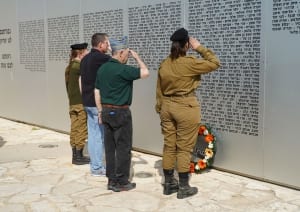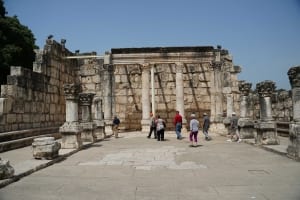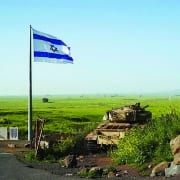Mission Accomplished
By Jack Du Teil
JWV’s Mission to Israel program is specifically designed to give non-Jewish veteran community leaders an opportunity to experience Israel first-hand so that they will see that Israel is America’s friend in the Middle East and our partner for peace in the region. Allied veterans return from Israel with a better understanding on aspects of the State of Israel’s security and so will use their new perspective to advocate on Israel’s behalf.
This year, Jack Du Teil, President of The Military Coalition and Executive Director of the United States Army Warrant Officers Association was selected to particiapte. His story is below.
Between March 31 and April 10, 2019, The Jewish War Veterans of the United States of America (JWV) conducted its 2019 Mission to Israel. An annual event, the mission was led by JWV National Commander Barry Schneider (Maj [Ret], USAF) and also included 3 other non-Jewish members of other veteran organizations.
I was fortunate enough to have been included in this adventure as a guest of this great organization. It turned out to be one of the most impactful trips I will likely ever make in my life, and I will be eternally grateful to the leadership of JWV for this incredible opportunity.
Visiting Israel only solidified my long-held belief that it is our nation’s most important, loyal ally in that entire region of the world. And the loyalty Israel demonstrates toward the USA is not just diplomatic at the leadership level – it is heartfelt by their citizenry.
There are many reasons for this, but at its core I believe this is directly related to the compulsory military service performed by the vast majority of Israelis as they become adults. By virtue of it – unlike American youths – they are made acutely aware of the constant threats to their liberty, by belligerent neighbors on every physical border.
Israel is very good at teaching the vast history of the Jewish people to its youngsters. Moreover, of necessity, they are also made acutely aware of the relatively short – and utterly miraculous – history of the modern State of Israel, and the hard lessons associated therewith.
Of Survival and Triumph
On our first full day in Israel, we visited Independence Hall, where David Ben Gurion – first prime minister of Israel – announced the nation’s declaration of independence on 14 May 1948. We also met with officials from Tzevet, the Israeli Defense Force (IDF) veterans organization. Tzevet’s Chairman, Major General Dr. Baruch Levy, provided us with an unclassified but quite thorough national security briefing.
Later that day, we visited the Haganah Museum. Tracing its roots to as early as 1907, the Haganah was formally organized in 1921, as an underground Jewish paramilitary organization during the British Mandate of Palestine (1921–48). With an eventual strength of 30,000 fighters it became the core of the IDF, following the United Nations’ approval of the partition of Palestine and Israel’s declaration of independence.
We also visited a secret ammunition factory set up underneath a kibbutz, called Givat Hakibbutzim. Code named the “Ayalon Institute,” the factory was manned by 45 Haganah boys and girls – between the ages of 14 and 18 – who manufactured millions of rounds of ammunition. Its secret was so closely guarded that even the other members of the kibbutz had no idea of its existence.
Within 24 hours of declaring independence, Israel was attacked not only by Palestinians, but also its other Arab neighbors. Had it not been for the foresight and bravery of the Haganah (and the ammunition manufactured at the Ayalon Institute), Israel would have quickly lost its war of independence.

At the Latroun Armored Corps Memorial Center
Our group also visited Armored Corps Memorial and Museum at the strategically crucial location of Latrun, Israel (captured from the Jordanians during the Six Day War of 1967). There, together with National Commander Schneider, I was honored to lay a wreath at the Wall of Remembrance, bearing the names of more than 5,000 Israeli casualties from Israel’s wars, dating back to 1948.
As solemn an occasion as this was, the most sobering place we visited was Yad Vashem, the Israeli Holocaust Museum. It was so engrossing and personally impactful, that our wonderful tour guides – IDF LTC (Ret) Ronit Nachman and her son Amit – had to retrieve me, so I would not miss the bus. To me, Yad Vashem is not something you can describe – it can only be experienced…and never forgotten.
So Often Miscast…
Far too often many in the American media seem to portray Israelis as “occupiers,” and pillory them as unreasonable negotiators, responsible for chronic unrest with the Palestinians. These arguments are vacuous, and born of the complete ignorance (or duplicity) of those making them.
Many point to Israel’s refusal to negotiate agreements using a “land for peace” approach. Not only do the historical events of the past century belie the potential success of such concessions, but one only needs to visit places like Latrun, the West Bank, and the Golan Heights to understand why they are simply strategically impossible to make (and it shouldn’t take a military genius to realize it).
And so, ignoring the unlikelihood of Israel ever successfully negotiating real peace, with an entity still constitutionally committed to the extermination of its people, Israelis are often portrayed as the bad guys in the media, and even (shamefully so) by elected officials in our country!
In fact, Israelis – as a people – are not only quite compassionate, but they are some of the most prolific contributors to the collective good of humankind. We visited two institutions on our trip, which underscore these points.
The first was the Galilee Medical Center (and level-one trauma center) at Nahariya, near the Syrian border. In the lobby you see a glass display case, containing a Katyusha rocket that once struck the hospital.
This was the perfect prelude to a tour we took of the underground facilities later built – a carbon copy of the facilities upstairs. Fully equipped, including foodstuffs and a sophisticated ventilation system, it can accommodate the medical staff and patients within one hour after notification of an attack.
At the height of the Syrian civil war’s refugee crisis, media pundits were quick to report Israeli refusal to accept refugees (out of legitimate security concerns). What they neglected to report was how more than 4,000 of the most horrifically wounded casualties of that conflict had been treated at this and other Israeli hospital facilities.
With the approval of Prime Minister Netanyahu himself, the wounded and their immediate families were accommodated, at Israeli government expense, during the patients’ courses of treatment. As a Christian, the words “turning the other cheek” come to my mind….
Our group also visited the Weizmann Institute of Science, one of the world’s leading multidisciplinary basic research institutions in the natural and exact sciences. It is named for Dr. Haim Weizmann, the first president of the State of Israel and founder of the institute, and has a long history of investigation and discovery, rooted in a mission of advancing science for the benefit of humanity.
One only needs to do an internet search on the words “Israeli Inventions” to be amazed at the contributions the citizens of this small, young nation have made to medicine, science, technology, and even to the everyday lives of human beings across the planet.
Just the other day, I even discovered that the Waze application I use to navigate in my car was first developed and popularized by the Israeli company Waze Mobile. I would have loved to hear that story on the evening news.
Caretakers of Our Collective History
As a tidbit of autobiographical data, I happen to be a Christian. But my grandfather was raised in an Orthodox Jewish family, and I fell in love with my best friend and Jewish wife of 31 years.
From this perspective, I was awestricken by the degree to which Israelis have become the archeologists, caretakers, and guardians of so much of our collective history. Regardless of faith association they regard the excavation, preservation and protection of historical sites and artifacts in this land – so rich with ancient artifacts – as a national imperative.
 Because of this, in Capernaum I was able to stand in the ruins of a temple where Jesus preached, and view the foundation of Saint Peter’s house. I visited Masada and viewed the excavated and partially reconstructed palace fortress, built by King Herod, where hundreds of Jews grimly chose suicide over falling into Roman hands. And that afternoon, I floated in the Dead Sea.
Because of this, in Capernaum I was able to stand in the ruins of a temple where Jesus preached, and view the foundation of Saint Peter’s house. I visited Masada and viewed the excavated and partially reconstructed palace fortress, built by King Herod, where hundreds of Jews grimly chose suicide over falling into Roman hands. And that afternoon, I floated in the Dead Sea.
In Jerusalem, I prayed at the Western Wall. I touched the spot where Jesus lay in his manger (in the Church of the Nativity), walked the stations of the cross, and touched the slab on which his crucified body was anointed at the Church of the Holy Sepulcher. At Mount Zion, we visited King David’s Tomb and the Room of the Last Supper.
These are just a few of the places we visited. But were it not for Israel’s commitment to the discovery and preservation of history – and its partnership with the Vatican and numerous other religious, national organizations and institutions – this would not be possible. Many sites would still be buried.
Conclusions
At the beginning of this article I stated my belief in the importance of Israel as a key ally of the United States. Visiting the country, and interacting with its people only strengthened this belief. But I came away with a few more impressions.
By and large, the Israeli people are far more pro-American than they are portrayed in our country. This is not because they need America’s help to survive – to the contrary, they have been doing a spectacular job of this on their own, and indeed thriving.
The Israelis appreciate the alliance they have with us, for the same reasons we should reciprocate these feelings. The value in this alliance goes well beyond the obvious strategic, military rationale. Israel’s value as a partner is evident on many fronts, to include economics, science, agricultural development, and culture.
Finally, I would like to once again thank JWV for this incredible opportunity. I would also like to thank each and every one of the wonderful people in our group, for being part of the “trip of a lifetime.”
All photos courtesy of Michael Kapin.
Volume 73. Number 2. 2019




